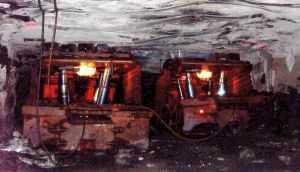Mining Feature: Brody Mine Accident Highlights Need for Retreat Mining Safety
Tuesday, May 20, 2014
On May 12, 2014, two mine workers—a continuous mining machine operator and a roof bolting machine operator—tragically lost their lives while working at the Brody Mine No. 1 in Boone County, West Virginia. According to initial reports, the two men were killed during a coal burst—a sudden outburst of coal and rock caused by the rupture of a supported roof, coal pillar, or wall.
The Brody Mine was engaged in retreat mining, which is a common practice in U.S. coal mines, particularly for mines located in the central Appalachian coalfields of southern West Virginia, eastern Kentucky, and western Virginia. In retreat mining, large pillars of coal are initially left in place during mining to support the weight of the overburden, then later the pillars are extracted for their coal, with the roof intentionally and systematically collapsed behind the removed pillars. Mines take extra measures to try to ensure safety during retreat mining, including the use of “breaker posts” set to break the roof off in a prearranged line, the installation of mechanized mobile roof supports that are moved as pillars are recovered, the use of longer and stronger roof bolts in areas that will be retreat mined, and the application of proven pillar design principles.
Given the inherent dangers of retreat mining, NIOSH has researched and documented the related challenges extensively and offers a number of targeted recommendations. Due to the increased risks associated with retreat mining, mine operators must be diligent in their designs to include geotechnical evaluations of every panel, including the barrier pillars—large, unmined pillars that protect mine workings from the high stresses that occur next to caved areas that were previously mined out. The products designed by NIOSH researchers should be an integral part of these geotechnical reviews. In some cases it may be advisable to conduct geotechnical evaluations both pre-mining and during mining.
NIOSH's suite of products related to retreat mining help mine operators and mine workers to anticipate the risks of roof falls based on the local geologic conditions, to avoid specific potential hazards in retreat mining operations, and to employ design principles that reduce the known risks. NIOSH also provides resources to help keep emergency responders safe if an incident occurs and when rescue or recovery efforts are undertaken. Below is a selective summary of key resources developed and recommended by NIOSH to enhance the safety of retreat mining operations.
Software
ARMPS (Analysis of Retreat Mining Pillar Stability) software is used to design pillars for room-and-pillar retreat mining. ARMPS calculates stability factors based on estimates applied to pillars, and features a pillar strength formula that considers the greater strength of rectangular pillars.
Conference Papers
Major Hazard Risk Assessment Applied to Pillar Recovery Operations discusses how major hazard risk assessment (MHRA) may help mine operators to mitigate risks associated with pillar recovery operations.
Reducing the Risk of Ground Falls during Pillar Recovery evaluates both global and local stability risk factors for pillar recovery based on field research and analysis of accident statistics.
Characteristics of Mining-Induced Seismicity Associated with Roof Falls and Roof Caving Events shows how analysis of microseismic emissions can aid in assessing the degree of instability associated with local rock failure processes.
Case Studies
Coal Mine Bumps: Five Case Studies in the Eastern United States describes the characteristics of coal mine “bumps”—sudden failures or movements of rock strata above and around coal mines that generate explosive forces.
Deep Cover Pillar Recovery in the US builds upon past NIOSH retreat mining research in the areas of pillar design, deep cover, and roof fall prevention. This study documented and added more than 200 retreat mining case histories to the Analysis of Retreat Mining Pillar Stability (ARMPS) data.
Reports
Research Report on the Coal Pillar Recovery under Deep Cover studies retreat mining practices in coal mines at depths greater than 1,500 feet, and includes recommendations to improve protections to miners working under deep cover.
Projects and Contracts
NIOSH's Emergency Response and Rescue programs capture training efforts, mine rescue simulations, underground exercises, and projects and contracts that help the underground mining industry develop workers who are fully prepared for self-escape under adverse conditions in the event of an incident.
See Also
- Current Trends in Reducing Ground Fall Accidents in US Coal Mines
- Deep Cover Pillar Recovery in the US
- Development and Application of the Coal Mine Roof Rating (CMRR)
- Diagnosing and Controlling Moisture-Sensitive Roof in Coal Mines
- Factors Influencing Intersection Stability in U.S. Coal Mines
- Performance Characteristics for Welded Wire Screen Used for Surface Control in Underground Coal Mines
- Potential of Roof Screening to Reduce Workers’ Compensation Cost
- Research Report on the Coal Pillar Recovery Under Deep Cover
- Roof Screening: Best Practices and Roof Bolting Machines
- Technology News 464 - Analysis of Retreat Mining Pillar Stability (ARMPS): Version 4.0 for Windows
- Page last reviewed: 10/22/2016
- Page last updated: 10/22/2016
- Content source: National Institute for Occupational Safety and Health, Mining Program


 ShareCompartir
ShareCompartir
